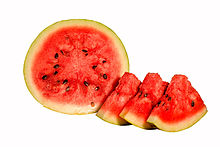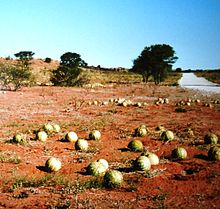
Back Акарпыжә Abkhazian Waatlemoen Afrikaans በጢሕ Amharic Citrullus lanatus AN بطيخ أحمر Arabic Citrullus lanatus AST Adi qarpız Azerbaijani عادی قارپیز AZB Ҡарбуз Bashkir Sumangka BAN
| Watermelon | |
|---|---|

| |
| Watermelon | |

| |
| Watermelon cross section | |
| Scientific classification | |
| Kingdom: | Plantae |
| Clade: | Tracheophytes |
| Clade: | Angiosperms |
| Clade: | Eudicots |
| Clade: | Rosids |
| Order: | Cucurbitales |
| Family: | Cucurbitaceae |
| Genus: | Citrullus |
| Species: | C. lanatus
|
| Binomial name | |
| Citrullus lanatus | |
| Synonyms[1] | |
|
List
| |


Watermelon (Citrullus lanatus) is a flowering plant species of the Cucurbitaceae family and the name of its edible fruit. A scrambling and trailing vine-like plant, it is a highly cultivated fruit worldwide, with more than 1,000 varieties.
Watermelon is grown in favorable climates from tropical to temperate regions worldwide for its large edible fruit, which is a berry with a hard rind and no internal divisions, and is botanically called a pepo. The sweet, juicy flesh is usually deep red to pink, with many black seeds, although seedless varieties exist. The fruit can be eaten raw or pickled, and the rind is edible after cooking. It may also be consumed as a juice or an ingredient in mixed beverages.
Kordofan melons from Sudan are the closest relatives and may be progenitors of modern, cultivated watermelons.[2] Wild watermelon seeds were found in Uan Muhuggiag, a prehistoric site in Libya that dates to approximately 3500 BC.[3] In 2022, a study was released that traced 6,000-year-old watermelon seeds found in the Libyan desert to the Egusi seeds of Nigeria, West Africa.[4] Watermelons were domesticated in north-east Africa and cultivated in Egypt by 2000 BC, although they were not the sweet modern variety. Sweet dessert watermelons spread across the Mediterranean world during Roman times.[5]
Considerable breeding effort has developed disease-resistant varieties. Many cultivars are available that produce mature fruit within 100 days of planting. In 2017, China produced about two-thirds of the world's total of watermelons.
- ^ "Citrullus lanatus (Thunb.) Matsum. & Nakai". World Flora Online. The World Flora Online Consortium. 2022. Archived from the original on 25 May 2022. Retrieved 25 May 2022.
- ^ Renner, Susanne S.; Wu, Shan; Pérez-Escobar, Oscar A.; Silber, Martina V.; Fei, Zhangjun; Chomicki, Guillaume (24 May 2021). "A chromosome-level genome of a Kordofan melon illuminates the origin of domesticated watermelons". Proceedings of the National Academy of Sciences. 118 (23): e2101486118. Bibcode:2021PNAS..11801486R. doi:10.1073/pnas.2101486118. ISSN 0027-8424. PMC 8201767. PMID 34031154.
- ^ Wasylikowa, Krystyna; van der Veen, Marijke (2004). "An archaeobotanical contribution to the history of watermelon, Citrullus lanatus (Thunb.) Matsum. & Nakai (syn. C. vulgaris Schrad.)". Vegetation History and Archaeobotany. 13 (4): 213–217. Bibcode:2004VegHA..13..213W. doi:10.1007/s00334-004-0039-6. ISSN 0939-6314. JSTOR 23419585. S2CID 129058509. Archived from the original on 24 March 2022. Retrieved 14 December 2020.
- ^ Pérez-Escobar, Oscar A.; Tusso, Sergio; Przelomska, Natalia A. S.; Wu, Shan; Ryan, Philippa; Nesbitt, Mark; Silber, Martina V.; Preick, Michaela; Fei, Zhangjun; Hofreiter, Michael; Chomicki, Guillaume; Renner, Susanne S. (3 August 2022). "Genome Sequencing of up to 6,000-Year-Old Citrullus Seeds Reveals Use of a Bitter-Fleshed Species Prior to Watermelon Domestication". Molecular Biology and Evolution. 39 (8): msac168. doi:10.1093/molbev/msac168. ISSN 1537-1719. PMC 9387916. PMID 35907246.
- ^ Paris, Harry S. (August 2015). "Origin and emergence of the sweet dessert watermelon, Citrullus lanatus". Annals of Botany. 116 (2): 133–148. doi:10.1093/aob/mcv077. PMC 4512189. PMID 26141130.
© MMXXIII Rich X Search. We shall prevail. All rights reserved. Rich X Search